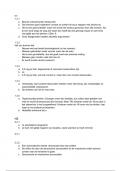FEMININE IDEALS IN FAIRYTALES CHANGED SINCE THE
PUBLICATION OF ‘KINDER AND HAUSMARCHEN?’
Eve Hunt
CANDIDATE NUMBER: 7347 Centre Number: 20924
,Eve Hunt
7347
20924
Contents
Introduction…………………………………………………………………………………………………….Page 2-3
Literature Review and Current Research into the Topic……………………………………Page 3-6
The Brother’s Grimm and Creating the Female Narrative ……………………………… Page 6-7
Female Beauty and Creating ‘Gender Imagery’……………………………………………….Page 7-9
How Writers are Changing ‘Gender Imagery.’ ……………………………………………….Page 9-10
The Wicked Stepmother……………………………………………………………………………… Page 11-12
Feminist Interpretations of the Role of the Wicked Stepmother………………….. Page 12-14
Cameron Dokey and Changing the Narrative In the 21 st Century………………….. Page 14-16
Conclusion…………………………………………………………………………………………………… Page 17-18
Bibliography………………………………………………………………………………………………... Page 18-21
1
, Eve Hunt
7347
20924
Introduction
Fairy tales are a rite of passage, passed down through generations. Initially these were oral tales told amongst
communities as a means of bonding, telling oral tales was a familiar pastime, storytelling to adults-by-adults. 1
In the interpretations of fairy tales, Marie Franz described them as ‘the international language of all mankind
of all ages and of all races and cultures’2 highlighting their universal impact on human development and social
conditioning. The conversion of fairy tales from oral tradition to the written form in the 19 th century has led to
their meanings changing, along with the circulation becoming something much more privatised. Individuals
could now buy copies of the tales and read them independently, therefore shifting expectation of the tales
from, at times, dark and ominous folk stories, to lighter stories with a happy ending. The shift in expectation
when reading these tales has altered how characters were depicted, and whilst society's perspective of women
in the 19th century can be viewed as discriminatory, these were the ideals influencing the culture of the time
and have subsequently manifested through to current literature in the form of fairy tale retellings, something
we regard today as ‘classic’ fiction.
The Brothers Grimm are highly influential figures in the realm of fairy and folk tale, their rich and unique tales
are listed by UNESCO world heritage in its ‘Memory of The World Registry,’ further emphasising the
importance of their work. Poet W.H Auden described the collection as ‘one of the founding works of the
western culture’3 and the impact that the brothers have had on the genre has formed the basis of this
investigation, as modern retellings have been shaped around the original essence of the tales in ‘Kinder and
Hausmarchen.’ The aim of this essay is to explore how changing times and influences have impacted the
portrayal of female characters in fairy tales. It is only recently, in the second half of the 21 st century, that
women have been regarded as equal to their male counterparts and gender equality has been a reinforced
message in western social spheres. This is highlighted by recent pieces of legislation such as the ‘Equality Act
2010’ which enforces the idea that ‘you must not be discriminated against because: you are (or are not) a
particular sex.’4 This project will determine if changing societal views have influenced how adaptations,
retellings and new versions of classic fairy tales portray gender or whether the binary set up by the Brothers
Grimm has perpetuated the future of fairy tales.
1
J. Zipes, When Dreams Come True: Classical Fairy Tales and Their Tradition (Routledge: New York, 2007), 5-10
2
M.L.V, Franz, Interpretations of Fairy Tales, (Boston: Shambala, Random House, 1996), 27.
3
W,H. Auden, The Complete Works of W.H.Auden Vol II Prose, (Princeton N.J.:Princeton University Press, 2002)
4
Participation, Expert. Equality Act 2010, (Government legislation, 2010) www.legislation.gov.uk/ukpga/2010/15/contents
2










